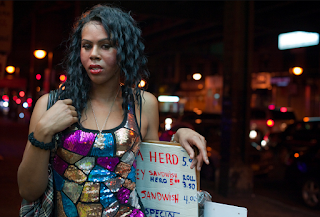Arnade has also photographed the pigeon keepers of New York, the people of Brownsville and East New York, the tricked-out bikes of New York, and much more, including the transgender sex workers of Jackson Heights, Queens. When we look to the Meatpacking District and wonder where did all those girls go -- they went here.

all photos by Chris Arnade
The following text is excerpted from an essay by Chris Arnade, from his flickr page:
At 4:00 am the 7 train over Roosevelt Avenue provides the rhythm for Jackson Heights, Queens. Each train spills out people from the late shift and fills with others going to the early shift.
The closing of the bars brings another rush: Drunken men to the sidewalks and hack cabs to the streets.
It is also the time the transsexuals start working, selling sex. They stand out: Tall, heavily made-up black and Hispanics dressed for show. They cluster about one intersection flirting with passing men and dodging the desperately drunk ones.
Their corner has two all-night bakeries where they rest. The young women working the bakeries know all of them; they have their drinks ready without the need to ask.

Jessica sits and sips her coffee. “Why 4:00 am? Because the men are so drunk they can kiss me and still pretend they are not gay.” Across from her is Claudia dabbing makeup on her face. “Hispanic men have to be all macho. Being gay is a no-no. This late, perhaps nobody will know, not their family. Even they can pretend.”
At the next table sit two men in dirty work-clothes eating plates of rice and meat.
None of the Johns say they are gay. “The men out here are in the closet or they don’t want to believe what they really like. They look for us to say they’re looking for a woman, but they know what it really is. There are more closeted gay people than we know.”
The transsexuals do not consider themselves gay. They are women who like men. “I am not gay. I am a woman. I just want what every other woman wants, a tall white handsome guy like you. Do me a favor, forget that camera and give me a big kiss, honey.”

They almost all come from very modest backgrounds and from places where homosexuality is not only shunned but a sin. They knew they were different early.
Desire, from Jamaica, knew when she was six. “My dad hated who I was. Jamaicans hate fags.” It took until the age of sixteen, when she went to jail and was happy for the attention of the other men that she was able to come out. “Guys started liking me in jail.”
Jessica from Puerto Rico had the same story. “I always knew I was different, from five. I did not want my penis. I wanted what the girls had. I came here because it’s better to be this way in New York than where I come from.”

Chris Arnade has since left New York City. He wrote an essay for The Awl about what he'll miss about Brooklyn. You can find his photos on Flickr.








































